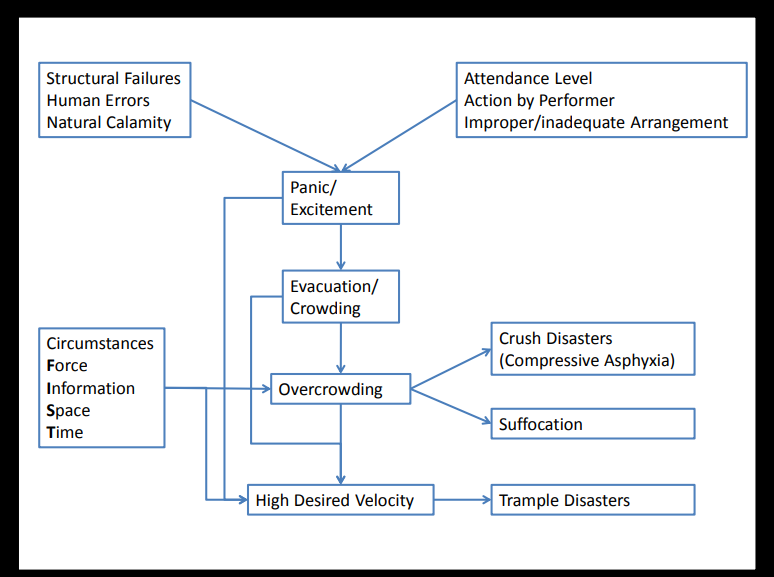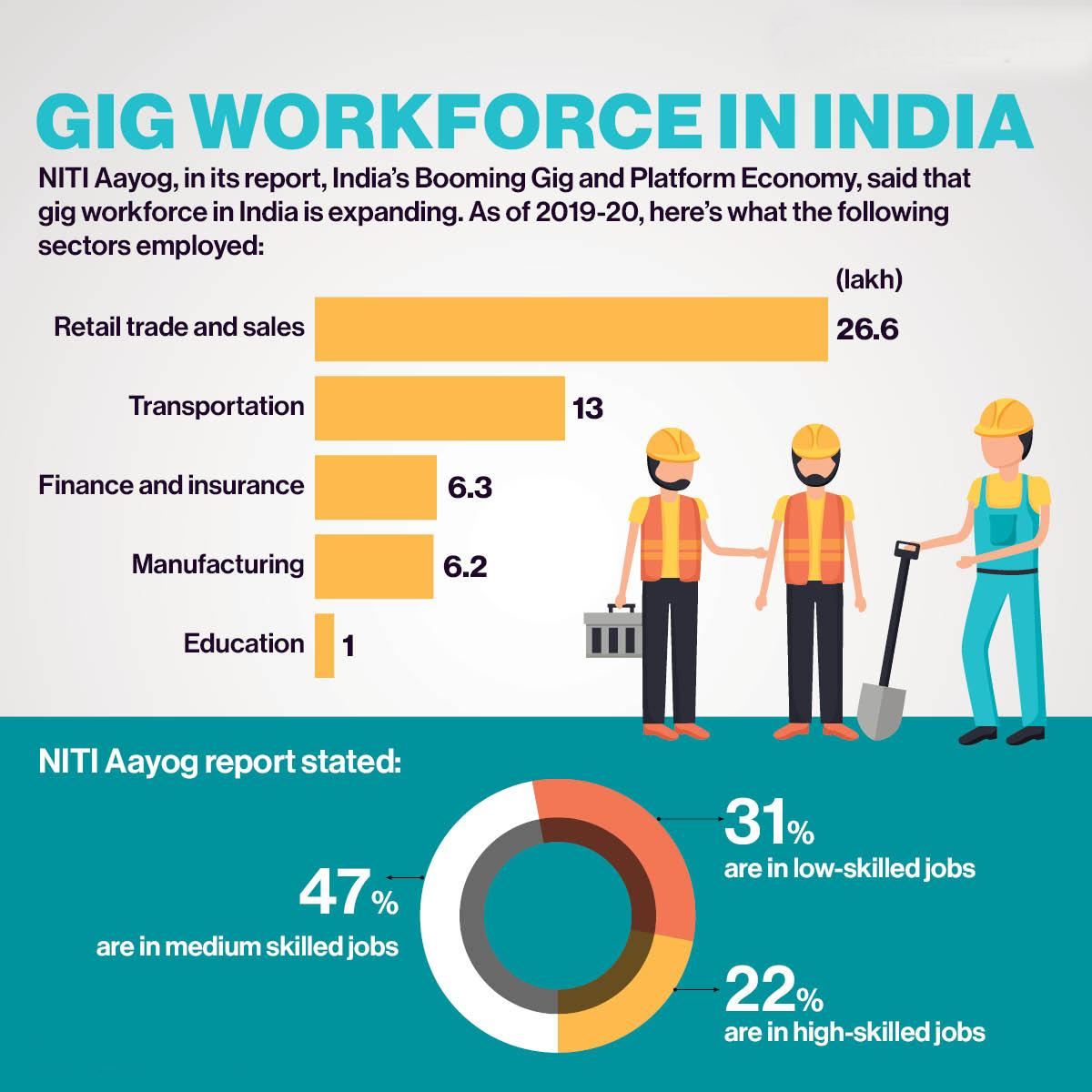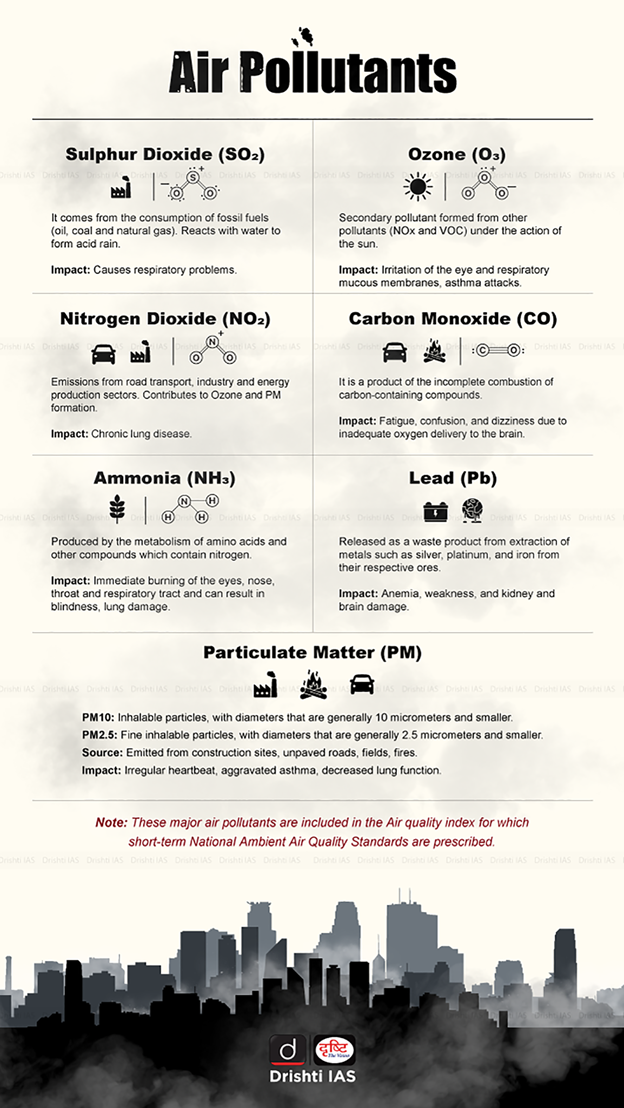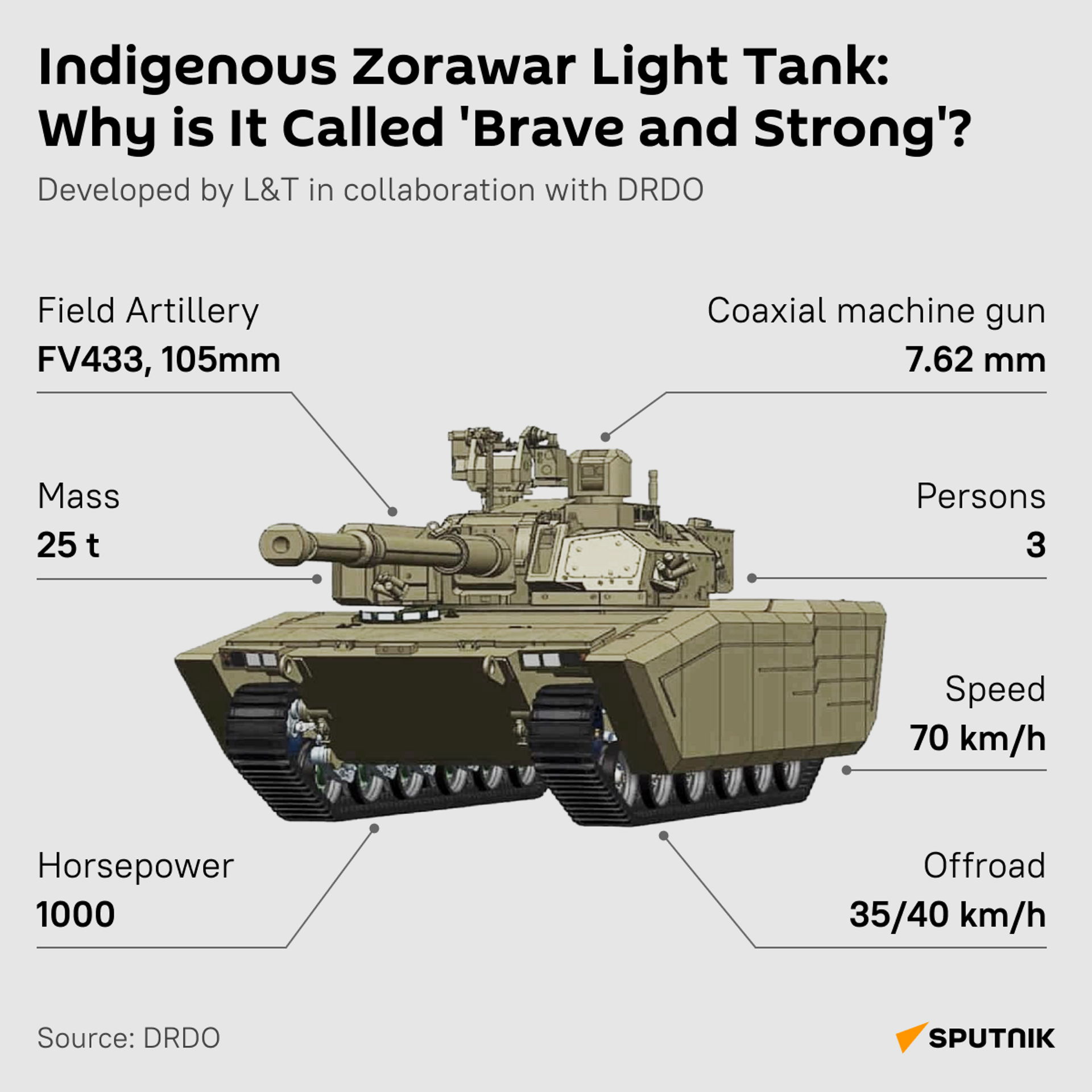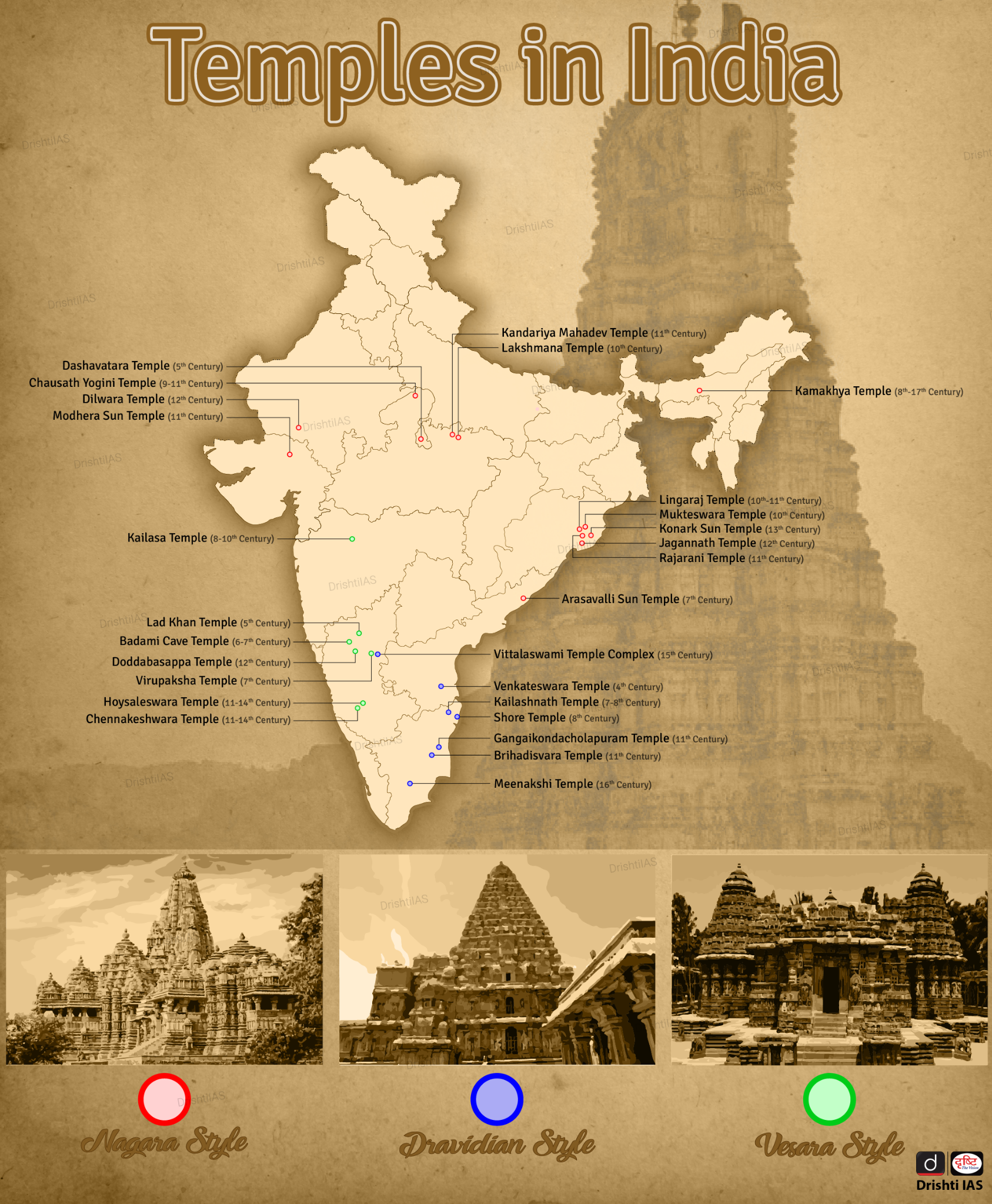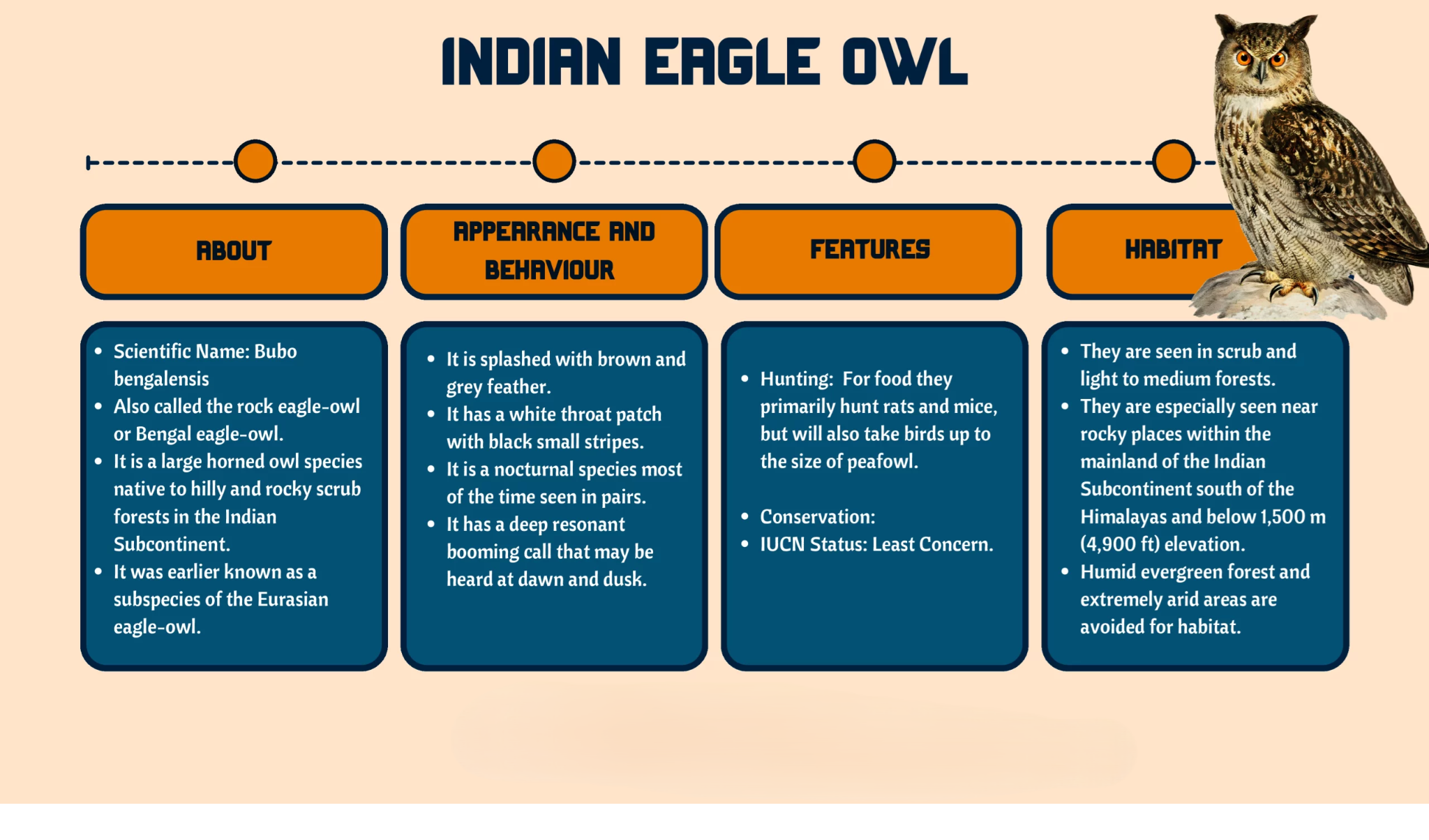Disaster Management and Stampedes
For Prelims: National Disaster Management Authority, Disaster Management Act, 2005, Radio Frequency Identification (RFID)
For Mains: Disaster Management, Strategy to address Stampede Management challenges.
Why in News?
Recently, India witnessed another tragic stampede that claimed over 100 lives in Uttar Pradesh's Hathras district.
- This devastating incident adds to a long list of similar tragedies that have occurred during religious gatherings and festivals across the country over the past two decades.
- These events highlight the ongoing challenges of managing large crowds in confined spaces and underscore the urgent need for improved safety measures.
What is a Stampede?
- About: A stampede is an impulsive mass movement of a crowd that often results in injuries and deaths. It is often triggered by response to a perceived danger, loss of physical space and a collective will to attain something seen as gratifying.
- Types: Two main types of stampedes are Unidirectional stampedes occur when a crowd moving in the same direction encounters a sudden change in force, triggered by forces like sudden stops or negative forces like broken barriers.
- Turbulent stampedes happen in situations with uncontrolled crowds, induced panic, or crowds merging from multiple directions.
- Fatalities in Stampedes: Stampedes can cause fatalities through:
-
Traumatic Asphyxia: It is the most common cause that occurs due to external compression of the thorax or upper abdomen. Can happen even in moderate crowds of 6-7 people pushing in one direction.
-
Other causes: Myocardial infarction (heart attack), Direct crushing injuries to internal organs, Head injuries and Neck compression.
-
-
Factors Contributing to Stampedes:
- Psychological Factors: Panic is a primary trigger or amplifier of stampedes.
- Loss of cooperative behaviour in emergencies. In panic-producing situations, cooperation is initially beneficial. Once cooperative behaviour is disturbed, individual survival instincts take over and result in stampedes.
- Environmental and Design Elements:
- Lack of proper lighting.
- Poor crowd flow management (Failure to divide crowd flow for different groups).
- Collapse of barriers or buildings.
- Blocked exits or evacuation routes.
- Fire hazards.
- High crowd density, when density approaches 3-4 persons per square metre. At this density, evacuation time increases dramatically, raising panic and stampede risk.
- Psychological Factors: Panic is a primary trigger or amplifier of stampedes.
- Impact of Stampedes:
-
Psychological Trauma: Survivors and witnesses may experience long-term psychological trauma, including Post-traumatic Stress Disorder (PTSD).
-
Economic Consequences: Stampedes primarily affect economically disadvantaged individuals, leaving families without primary earners and causing significant economic hardship in the community.
- Medical expenses, compensation, legal costs, and loss of economic productivity due to injuries.
- Social Impact: Includes loss of trust in event organisers and authorities, social unrest and blame, and negative impact on community morale and cohesion.
-
The aftermath can have far-reaching consequences, requiring efforts to address the underlying issues and prevent similar incidents.
-
-
Impact on Infrastructure: It can cause damage to physical infrastructure, such as barriers and buildings. The costs associated with repairs and upgrades to infrastructure can be significant.
-
What were the Circumstances of Previous Deadly Stampedes in India?
- Mata Vaishno Devi Shrine (2022): 12 killed in a crowd surge during a Hindu pilgrimage in Kashmir.
- Mumbai Pedestrian Bridge (2017): 22 died in a stampede during rush hour.
- Varanasi Bridge (2016): 24 killed crossing a crowded bridge for a religious ceremony.
- Godavari River (2015): 27 dead in a stampede during a Hindu bathing festival.
- Ratangarh Temple (2013): 115 died in a stampede caused by a collapsing bridge.
- Allahabad Train Station (2013): 36 killed due to a platform change during Kumbh Mela.
- Jodhpur Temple (2008): 168 deaths in a stampede during Navratra festival celebrations.
- Naina Devi Temple (2008): 145 killed in a stampede triggered by rumors of a landslide.
- Wai Temple (2005): 258 lives lost in a stampede and subsequent fire.
What are the Initiatives of India to Control Stampedes?
- The National Disaster Management Authority (NDMA) provides guidelines for safe crowd management and precautions during festive seasons.
- Traffic and Crowd Management: NDMA advises regulating traffic, displaying route maps, and using barricades to control pedestrian flow around festive venues.
- Security Measures: Emphasising CCTV surveillance and increased police presence to deter crimes, NDMA urges organisers to manage unauthorised parking and stalls effectively.
- Medical Preparedness: NDMA recommends having ambulances on standby and medical staff ready, with clear signage directing to nearby hospitals.
- Crowd Safety Tips: Educating attendees on exit routes and calm behaviour during gatherings, NDMA stresses preparedness for handling stampede scenarios.
- Fire Safety: NDMA highlights precautions such as safe electrical wiring, monitoring LPG cylinder usage, and caution with fireworks to prevent fires.
- Disaster Risk Reduction: NDMA supports government initiatives and upcoming conferences like the Asian Ministerial Conference in collaboration with United Nations International Strategy for Disaster Reduction (UNISDR), focusing on disaster resilience and recognizing the sendai framework.
- Community Responsibility: NDMA underscores collective responsibility in disaster prevention and promoting safety during festive events.
National Disaster Management Authority (NDMA)
- The NDMA, led by the Prime Minister of India, is the apex statutory body for Disaster Management in the country. It was established as per the Disaster Management Act, 2005 to create institutional mechanisms at the State and District levels.
- NDMA is responsible for setting policies, plans, and guidelines for Disaster Management, with a focus on prevention, mitigation, preparedness, and response.
- It aims to create a safer and disaster-resilient India through a proactive and sustainable development strategy.
What Can be Done Better to Prevent Stampedes?
- Real-time Density Monitoring: Deploy a network of sensors (thermal, LiDAR) to monitor crowd density in real-time. This data can feed into AI models to predict crowd surges and trigger early warnings.
- Introduce Radio Frequency Identification (RFID) tags in tickets or wristbands. This allows for real-time tracking of crowd movement, identifying congested areas, and enabling targeted communication via displays.
- Utilise drones equipped with high-resolution cameras and thermal imaging for real-time crowd surveillance and anomaly detection. These can also project calming messages or announcements on large screens.
- Intelligent Lighting Systems: Implement crowd-responsive lighting that can adjust brightness and colour based on crowd density to guide movement or calm situations.
- Implement pathways and walkways embedded with bioluminescent materials that automatically glow brighter in case of emergencies. This can guide movement and reduce panic in low-light situations.
- Interactive Communication Displays: Install interactive displays that show real-time wait times, evacuation routes, and essential information in multiple languages.
- Campaigns: Launch public awareness campaigns to educate people on crowd safety protocols and proper behaviour during large gatherings.
|
Drishti Mains Question: Q. Analyse the effectiveness of disaster risk reduction initiatives by the Indian government in the context of stampede prevention. What improvements can be made? |
UPSC Civil Services Examination, Previous Year Questions (PYQs)
Mains
Q. Discuss the recent measures initiated in disaster management by the Government of India departing from the earlier reactive approach. (2020)
Social Security for Gig Workers
For Prelims: Rajasthan, Gig Workers, Social Security Schemes, National Human Rights Commission (NHRC), Code on Wages 2019, Code on Social Security 2020, NITI Aayog,
For Mains: Significance of Social Security, and Welfare Schemes for Inclusive Development.
Why in News?
Recently, Karnataka became the second state after Rajasthan to come up with legislation for Gig Workers.
- Through a draft version of the law (Karnataka Platform-based Gig Workers (Social Security and Welfare) Bill), the Karnataka government aims to regulate the social security and welfare of platform-based gig workers in the state by creating a board, welfare fund, and grievance cell among the mechanisms.
Gig Workers Union Demands National Disaster Status for Heatwave
- The Union of gig workers in Telangana have sought National Human Rights Commission (NHRC) to consider the effect of the heatwave on gig workers.
- The Union is demanding that the heatwave be treated as a national disaster and support systems be created for workers.
- The set of 10 demands including intervention of the State government in terms of providing clean drinking water, oral rehydration, accessible toilets, seating areas with shade, a mandatory break with flexible working hours during extreme heat conditions has been put forward.
What are the Key Highlights of the Karnataka Bill?
- Creation of Welfare Board: Board comprising Karnataka labour minister, two aggregator officials, two gig workers, and one civil society member to be formed.
- A two-level grievance redressal mechanism for workers, and more transparency with regards to the automated monitoring and decision-making systems deployed by platforms has been envisaged by the draft bill.
- Timely Payment: The draft mandates aggregators to make payments at least every week and to inform the worker about the reasons for any payment deductions.
- Unique ID: Gig workers can apply to receive a Unique ID applicable across all platforms upon registration with the board.
- Social Security and Grievance Redressal: Access to general and specific social security schemes based on contributions along with a grievance redressal mechanism for gig workers.
- Autonomy and Contractual Rights: The Bill aims to provide greater autonomy to the gig workers to terminate contracts and resist being over worked by employers.
- The aggregator shall not terminate a worker without giving valid reasons in writing and prior notice of 14 days.
- Work Environment and Safety: There is a mandate for aggregators to maintain a safe working environment for gig workers.
- Welfare Fund: Proposed fund financed by a welfare fee from aggregators along with state and worker contributions.
- Penalties: Basic penalty of Rs 5,000 extendable up to Rs 1 lakh for aggregators violating conditions under the Bill.
Who are Gig Workers?
- Gig Workers: As per the Code on Social Security 2020, a gig worker is a person who performs work or participates in a gig work arrangement and earns from such activities outside of traditional employer-employee relationship.
- Gig Economy: A free market system in which temporary positions are common and organisations contract with independent workers for short-term engagements.
- A 2022 NITI Aayog report estimates that India will have 23.5 million gig workers by 2029-30.
What is the Need to Provide Social Security Benefits to Gig Workers?
- Frequent Termination: The instances of blacklisting workers or terminating them from work without hearing out their side have increased.
-
Economic Security: The sector depends on demand which leads to job insecurity and income uncertainty, highlighting the necessity of providing social security benefits such as unemployment insurance, disability coverage, and retirement savings programs.
-
Health Insurance: Lack of access to employer-sponsored health insurance and other healthcare benefits leaves gig workers vulnerable to unexpected medical expenses. Prioritising their health and well-being will create a healthier and more productive workforce.
-
Level Playing Field: Exemption from traditional employment protections creates disparities where gig workers face exploitative working conditions and inadequate compensation. Providing social security benefits will level the playing field.
-
Long-term Financial Security: Without employer-sponsored retirement plans, gig workers may struggle to save enough for their future like for post retirement needs.
What are the Main Challenges in Providing Social Security Benefits to Gig Workers?
- Classification and Excess Flexibility: The gig economy is characterised by its flexibility, allowing workers to choose when, where, and how much they work.
- Designing social security benefits that accommodate this flexibility and meet the diverse needs of gig workers is a complex task.
- Funding and Cost Distribution: Traditional social security systems depend on employer and employee contributions, with employers typically bearing a significant portion of the costs.
- In the gig economy, where workers are often self-employed, identifying appropriate funding mechanisms becomes complex.
- Coordination and Data Sharing: Efficient data sharing and coordination among gig platforms, government agencies, and financial institutions are necessary to accurately assess gig workers' earnings, contributions, and eligibility for various social security programs.
- However, as gig workers often work for multiple platforms or clients, it becomes challenging to coordinate and ensure proper coverage.
- Education and Awareness: Many gig workers may not fully understand their rights and entitlements regarding social security benefits.
- Raising awareness and providing education about the importance of social security, eligibility criteria, and the application process is a challenging task.
Government’s Initiatives Related to Gig Workers
- The Code on Social Security 2020, contains a separate section on ‘gig economy’ and imposes an obligation on gig employers to contribute to a Social Security Fund to be handled by a government-led board.
- The Code on Wages 2019, provides for universal minimum wage and floor wage across organised and unorganised sectors, including gig workers.
- The Rajasthan Assembly recently passed a bill aimed at extending social security benefits to gig workers.
What can be done to Ensure Social Security of Gig Workers?
- Implementing Code on Social Security, 2020: Although the Code on Social Security, 2020, contains provisions for gig workers, the rules are yet to be framed by the States and not much has moved in terms of instituting the Board. These should thus be taken up expeditiously by the government.
-
Expanding Employer Responsibilities: Strong support for gig workers should come from the gig companies that themselves benefit from this agile and low-cost work arrangement.
- The practice of classifying gig workers as self-employed or independent contractors needs to be eliminated.
- Companies must be provided equal benefits as that of a regular employee.
- Education and Training: The government should invest in education and training programs for gig workers to improve their skills and increase their earning potential.
- Government Support: Collaboration between governments, gig platforms, and labour organisations to establish fair and transparent mechanisms for sharing the responsibility of providing social security benefits.
-
Eg. Schemes similar to Ayushman Bharat should be extended to cover gig workers with cost sharing with the employer.
-
-
Adopting International Examples: The UK has instituted a model by categorising gig workers as “workers,” which is a category between employees and the self-employed.
- This secures them a minimum wage, paid holidays, retirement benefit plans, and health insurance.
- Similarly, in Indonesia, they are entitled to accident, health, and death insurance.
- Linking Women Empowerment with Gig Economy: There is a need to build the right physical and social infrastructure that supports the engagement of women in the gig workforce.
|
Mains Question: Discuss the need and challenges associated with providing social security for gig workers in India. Also, highlight steps taken by centre and state governments in this context. |
UPSC Civil Services Examination, Previous Year Question (PYQ)
Prelims:
Q. Consider the following: (2012)
- Hotels and restaurants
- Motor transport undertakings
- Newspaper establishments
- Private medical institutions
The employees of which of the above can have the ‘Social Security’ coverage under Employees State Insurance Scheme?
(a) 1, 2 and 3 only
(b) 4 only
(c) 1, 3 and 4 only
(d) 1, 2, 3 and 4
Ans: (d)
Mains:
Q. How globalization has led to the reduction of employment in the formal sector of the Indian economy? Is increased informalization detrimental to the development of the country? (2016)
Appointment to Cabinet Committees
For Prelims: Cabinet committees, Lok Sabha Speaker, Members of Parliament, Prime Minister, Standing committees
For Mains: Challenges for Cabinet Committees, Suggestions for Cabinet Committees
Why in News?
Recently, the Union government constituted eight Cabinet committees, with the Cabinet Committee on Economic Affairs (CCEA) getting three new faces and the Appointments Committee of the Cabinet (ACC) and Cabinet Committee on Security (CCS) remaining unchanged.
- In another development Lok Sabha Speaker has amended the oath-taking rules for Members of Parliament, prohibiting them from adding any remarks during their oath as members of the House.
What are Cabinet Committees?
- About:
- A Cabinet Committee is a subset of the Union Cabinet, consisting of selected Union Ministers.
- These committees are established to streamline decision-making by dividing responsibilities among different groups, such as those dealing with economic affairs, security, parliamentary affairs, and political affairs.
- They provide detailed consideration and ensure efficient handling of complex issues, which are then presented to the full Cabinet for final approval.
- They are based on the principles of division of labour and effective delegation.
- Type:
- Standing (Permanent nature)
- Ad hoc (Temporary nature to deal with special problems)
- Features of Cabinet Committees: They are extra-constitutional in nature and the Rules of Business provide for their establishment.
- The executive in India works under the Government of India Transaction of Business Rules, 1961.
- The rules come from Article 77(3) of the Constitution, which says the President makes rules for smooth government operations and assigns tasks among Ministers.
- The executive in India works under the Government of India Transaction of Business Rules, 1961.
- Membership:
-
They are set up by the Prime Minister according to the exigencies of the time and requirements of the situation.
-
Their membership varies from three to eight. They usually include only Cabinet Ministers. However, the non-cabinet Ministers are not debarred from their membership.
- They not only include the Ministers in charge of subjects covered by them but also include other senior Ministers.
- In case the Prime Minister is a member of a committee, he invariably presides over it.
- They not only sort out issues and formulate proposals for the consideration of the Cabinet, but also take decisions. However, the Cabinet can review their decisions.
-
- List of 8 Cabinet Committees:
- Cabinet Committee on Economic Affairs (CCEA)
- Appointments Committee of the Cabinet (ACC)
- Cabinet Committee on Security (CCS)
- Cabinet Committee on Accommodation
- Cabinet Committee on Parliamentary Affairs (referred as Super-Cabinet)
- Cabinet Committee on Political Affairs
- Cabinet Committee on Investment and Growth
- Cabinet Committee on Skill, Employment and Livelihood
- Recent Changes:
- The Home Minister is the sole Cabinet member to feature on all these panels.
- The Prime Minister heads all six committees except the Committee on Accommodation and the Cabinet Committee on Parliamentary Affairs.
- No change has been made in the Appointments Committee, which is headed by the Prime Minister and where the Home Minister is the sole member.
Parliamentary Committees
- Parliamentary committees are specialised committees formed to handle the detailed work of the Parliament, which is often too complex and extensive to be conducted within the full sittings of the Houses.
- They are essential for ensuring detailed scrutiny, discussion, and investigation into specific matters. There are various types of parliamentary committees like Standing Committees, Departmentally Related Standing Committees (DRSCs) etc.
Groups of Ministers
- These are ad hoc bodies formed to give recommendations to the cabinet on certain emergent issues and critical problem areas.
- Some of these GoMs are empowered to take decisions on behalf of the Cabinet whereas the others make recommendations to the Cabinet.
- The institution of GoMs has become a viable and effective instrument of coordination among the ministries.
- Ministers heading the concerned ministries are inducted into the relevant GoMs and when the advice is crystallised they are disbanded.
Lok Sabha Speaker Amends Oath-Taking Rules For MPs
- A new clause has been added to ‘Direction 1’ within the ‘Directions by the Speaker’ to manage specific matters related to the House's functioning that are not explicitly covered by existing rules.
- According to the amendment to ‘Direction 1’, the new clause 3 states that a member shall take and subscribe to the oath or affirmation without using any words or expressions as prefixes or suffixes to the prescribed form.
What are the Challenges of the Cabinet Committees?
- Overlapping Mandates: It leads to delays, inefficiency, and conflict between committees as they fight for control. Proposals get stuck and decisions are slow.
- Lack of Expertise: A committee focused on healthcare policy might not have medical professionals on board. This can lead to poorly informed decisions with unintended consequences. Thus lack of experts can result in long term policy ramifications.
- Information Silos & Poor Communication: Committees might operate in isolation, not sharing information or collaborating. This creates blind spots and hinders a holistic approach. It leads to duplication of effort, missed opportunities for synergy, and decisions based on limited information.
- Political Pressure & Short-termism: Political considerations can push committees to prioritise short-term gains over long-term strategic planning. This can lead to reactive measures instead of proactive solutions.
- Lack of Accountability & Transparency: The decisions made should not be shrouded in secrecy as it leads to erosion of trust. Without clear information about committee activities and decisions, the legislature can't hold them accountable.
- Concentration of Power: If decision-making authority rests with only a few committees or individuals, valuable perspectives might be excluded. This can lead to unbalanced decisions. Important voices might not be heard, potentially overlooking creative solutions and fostering resentment among excluded parties.
Way Forward
- Clear Mandate: Clearly define committee mandates to avoid ambiguity. Establish a central conflict resolution body for inter-committee disputes.
- Expert Appointment: Appoint subject matter experts as advisors or temporary committee members. Partner with external think tanks for specialised knowledge.
- Better Information Sharing: Implement a centralised information sharing platform for all committees. Establish regular inter-committee briefings to foster collaboration.
-
Long-Term Goals: Mandate committees to develop long-term strategic plans alongside short-term action items. Integrate independent economic or social impact assessments into decision-making.
-
Accountability: Regularly release meeting minutes and summaries ensures accountability.
-
Broad-Based Consultation: The consultation should be more broad-based. Inviting other cabinet members as special invitees.
|
Drishti Mains Question: Discuss the role and significance of Cabinet Committees. Suggest measures to enhance their effectiveness in policy formulation and implementation. |
UPSC Civil Services Examination, Previous Year Question (PYQ)
Prelims:
Q. Which of the following is/are the function/functions of the Cabinet Secretariat? (2014)
- Preparation of agenda for Cabinet Meetings
- Secretarial assistance to Cabinet Committees
- Allocation of Financial resources to the Ministries
Select the correct answer using the code given below:
(a) 1 only
(b) 2 and 3 only
(c) 1 and 2 only
(d) 1, 2 and 3
Ans: (c)
Mains:
Q. To what extent, in your view, the Parliament is able to ensure accountability of the executive in India? (2021)
Air Pollution and Mortality in Indian Cities
Why in News?
Recently, Lancet has published a first multi-city study examining the relationship between short-term air pollution (PM2.5) exposure and mortality in 10 major cities of India between 2008 and 2019.
What are the Key findings of the Study?
- Air Pollution Causing Death: The study revealed that over 33,000 deaths (approximately 7.2% of total mortalities) could be attributed to air pollution annually across the 10 investigated cities.
- Highest Mortality Burden: Delhi, exhibited the most severe air pollution, with a staggering 11.5% (12,000 deaths) of annual deaths linked to air pollution.
- Shimla Lowest Mortality: Shimla emerged as the city with the lowest mortality burden attributable to air pollution, with only 59 deaths (constituting 3.7% of total deaths) annually.
- Chronic Exceedance of Safe Air Quality Standards: There has been a persistent violation of established air quality standards. PM2.5 concentrations consistently exceeded the World Health Organization's (WHO) safe limit (15 μg/m³) on an alarming 99.8% of the days analyzed.
- Deteriorating Health with Increasing Pollution Levels: Every 10 μg/m³ increase in PM2.5 concentration demonstrably resulted in a 1.42% rise in mortality across the ten cities.
- Cities with comparatively lower pollution levels, such as Bengaluru and Shimla, exhibited a heightened susceptibility to mortality increases with even incremental rises in PM2.5 concentrations.
Read More: Advancing Air Pollution Control in India, World Air Quality Report 2023
UPSC Civil Services Examination Previous Year Question (PYQ)
Prelims
Q. In the cities of our country, which among the following atmospheric gases are normally considered in calculating the value of Air Quality Index? (2016)
- Carbon dioxide
- Carbon monoxide
- Nitrogen dioxide
- Sulfur dioxide
- Methane
Select the correct answer using the code given below:
(a) 1, 2 and 3 only
(b) 2, 3 and 4 only
(c) 1, 4 and 5 only
(d) 1, 2, 3, 4 and 5
Ans: (b)
Mains
Q. Describe the key points of the revised Global Air Quality Guidelines (AQGs) recently released by the World Health Organisation (WHO). How are these different from its last update in 2005? What changes in India’s National Clean Air Programme are required to achieve revised standards? (2021)
Gaganyaan Astronauts Selected for Axiom-4 Mission
Why in News?
The Indian Space Research Organisation (ISRO) has shortlisted two of its four trained Gaganyaan astronauts for the Axiom-4 mission to the International Space Station (ISS) in collaboration with the United States' National Aeronautics and Space Administration (NASA).
What is the Axiom-4 Mission?
- NASA and Axiom Space, an american privately funded space infrastructure developer signed an order for the fourth private astronaut mission to the ISS, aiming to launch in August 2024 from Kennedy Space Center in Florida.
- The mission aims to dock with the ISS for a fourteen-day duration.
- Indian astronauts will receive training from NASA, international partners, and SpaceX, focusing on spacecraft systems and emergency preparedness, as part of India-US space cooperation goals.
Note
The joint statement by India and the United States during Prime Minister’s visit in 2023 said NASA would provide ‘advanced training’ to Indian astronauts at one of its facilities, as part of the Artemis Accords.
Status of India's Gaganyaan Program
- India's Gaganyaan human spaceflight is expected post-2025, with unmanned flights as precursors.
- The launch of manned flights follows two successful unmanned missions.
What is the International Space Station (ISS)?
- The ISS is a large, permanently crewed laboratory that orbits Earth, 400 kilometres above its surface. It is home to astronauts and cosmonauts, and serves as a unique science laboratory.
- Its research is expected to lead to advancements in many areas, including medicine, technology, science, and understanding the Earth and universe.
- It's a collaboration between 15 countries and five space agencies namely NASA (United States), Roscosmos (Russia), ESA (European Space Agency), JAXA (Japan Aerospace Exploration Agency), and CSA (Canadian Space Agency).
- An international crew of seven people live and work while travelling at a speed of 7.66 km/sec, orbiting Earth about every 90 minutes. In 24 hours, the space station makes 16 orbits of Earth, travelling through 16 sunrises and sunsets.
- Peggy Whitson set the US record for spending the most total time living and working in space for 665 days.
- The first parts of the ISS were sent and assembled in orbit in 1998. Since the year 2000, the ISS has had crews living continuously on board.
Note:
- India is gearing up to strengthen its space presence, the ISRO aims to establish the country's first space station by 2035.
- ISRO aims to build a 20-ton space station within a decade to support microgravity experiments.
Read more: India Joins Artemis Accords
UPSC Civil Services Examination, Previous Year Question (PYQ)
Prelims:
Q. What is the purpose of the US Space Agency’s Themis Mission, which was recently in the news? (2008)
(a) To study the possibility of life on Mars
(b) To study the satellites of Saturn
(c) To study the colourful display of high latitude skies
(d) To build a space laboratory to study the stellar explosions
Ans: (c)
Q. Consider the following statements: (2016)
The Mangalyaan launched by ISRO
- is also called the Mars Orbiter Mission
- made India the second country to have a spacecraft orbit the Mars after USA
- made India the only country to be successful in making its spacecraft orbit the Mars in its very first attempt
Which of the statements given above is/are correct?
(a) 1 only
(b) 2 and 3 only
(c) 1 and 3 only
(d) 1, 2 and 3
Ans: (c)
Dalai Lama
Recently, the 89th birthday of Buddhist spiritual leader Dalai Lama was celebrated.
- The Dalai Lama belongs to the Gelugpa tradition of Tibetan Buddhism, which is the largest and most influential tradition in Tibet.
- There have been only 14 Dalai Lamas in the history of Tibetan Buddhism, and the first and second Dalai Lamas were given the title posthumously.
- The 14th and current Dalai Lama is Tenzin Gyatso.
- The Dalai Lamas are believed to be manifestations of Avalokiteshvara or Chenrezig, the Bodhisattva of Compassion and the patron saint of Tibet.
- Bodhisattvas are realised beings inspired by a wish to attain Buddhahood for the benefit of all sentient beings, who have vowed to be reborn in the world to help humanity.
- The Dalai Lama (14th) who fled from Tibet to India with thousands of followers during the Tibetan uprising 1959, has been residing in India since then.
Read more: Abhay Mudra in Buddhism, US Passed Resolve Tibet Act, Dalai Lama
India's Indigenous Light Tank Zorawar
The Defence Research and Development Organisation (DRDO) has unveiled the prototype of India's indigenous light tank, Zorawar, which is set to undergo extensive trials.
- It was jointly developed by DRDO and Larsen & Toubro (L&T) with contributions from various Micro, Small, and Medium Enterprises.
- The need for a light tank (weighing maximum 25 tonnes) emerged during the 2020 standoff with China in Eastern Ladakh, highlighting the requirement for lightweight, easily deployable tanks.
- In April 2021, the Army issued a Request for Information (RFI) for 350 light tanks weighing less than 25 tonnes.
- The light tank's design ensures it can be transported by air, fire at high angles, and perform limited artillery roles, enhancing tactical and operational mobility.
Samayapuram Temple
The Hindu Group of Publications has released a coffee-table book titled 'Samayapuram - The Sacred Seat of Shakti,' authored by Vrinda Ramanan, which explores the history and cultural significance of the Samayapuram temple dedicated to Goddess Mariamman.
- The temple located in Tiruchirapalli, Tamil Nadu is over 1,200 years old, is associated with legends of Goddess Mariamman, believed to be an incarnation of Goddess Durga, Mahakali, Adi Shakti, or Nishumbha Sudhini.
- The Mariamman temple has no historical evidence of its construction date, but is considered that it existed during the Chola period.
- The current Temple Complex was built by Vijayanagara King Vijayaraya Chakkaravarthi in the 18th century. It is also one of the wealthiest temples of Tamil Nadu.
- The Chithirai Ther Thiruvizha (Chariot Festival in the month of Chithirai - April) is a major festival celebrated annually at this temple for 13 days, starting on the 1st Tuesday of Tamil month Chithirai.
US to Kill Barred Owls
Recently, US wildlife officials have decided to kill Barred Owls (Strix varia) to help save the declining Spotted Owl (Strix Occidentalis) populations in the US.
- Under this plan, trained professionals and landowners will be allowed to shoot the barred owls. However, public hunting of barred owls will not be allowed.
- Barred owls are native to North America. They look similar to spotted owls.
- Barred owls are larger, more aggressive, and can readily adapt to their broad diet.
- Their invasion of the west of the US has put a heavy strain on the spotted owl, decreasing their populations by up to 65 to 85% between 1995 and 2017 in some areas.
- Killing would also help other species that they've been preying on such as salamanders and crayfish.
| Barred Owls | Spotted Owl | |
| IUCN Status | Least Concerned | Near Threatened |
| Habitat | Woodlands, wooded river bottoms, wooded swamps in North America | Mature forests of British Columbia and Washington. |
Read more: Spot Bellied Eagle Owl

